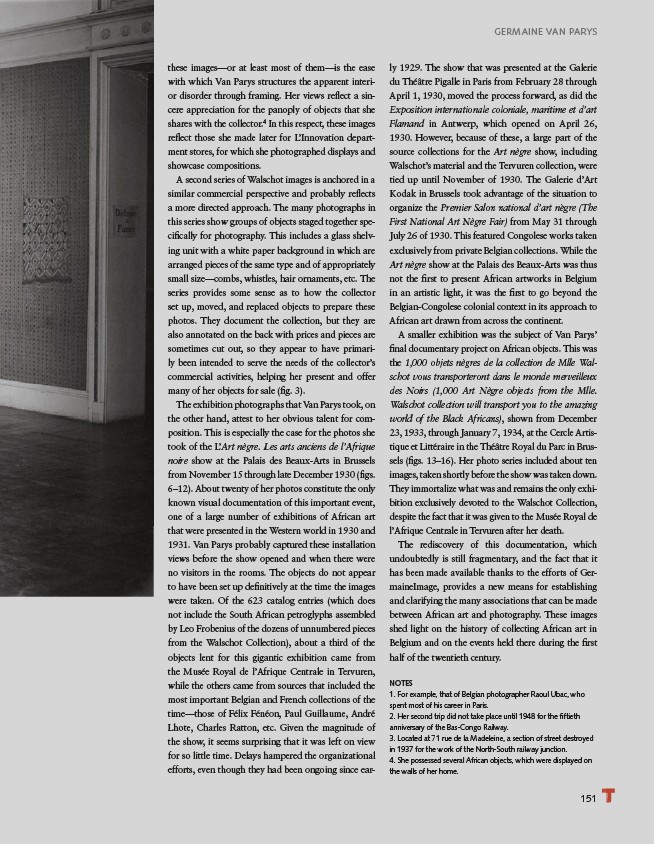
GERMAINE VAN PARYS
151
these images—or at least most of them—is the ease
with which Van Parys structures the apparent interior
disorder through framing. Her views refl ect a sincere
appreciation for the panoply of objects that she
shares with the collector.4 In this respect, these images
refl ect those she made later for L’Innovation department
stores, for which she photographed displays and
showcase compositions.
A second series of Walschot images is anchored in a
similar commercial perspective and probably refl ects
a more directed approach. The many photographs in
this series show groups of objects staged together specifi
cally for photography. This includes a glass shelving
unit with a white paper background in which are
arranged pieces of the same type and of appropriately
small size—combs, whistles, hair ornaments, etc. The
series provides some sense as to how the collector
set up, moved, and replaced objects to prepare these
photos. They document the collection, but they are
also annotated on the back with prices and pieces are
sometimes cut out, so they appear to have primarily
been intended to serve the needs of the collector’s
commercial activities, helping her present and offer
many of her objects for sale (fi g. 3).
The exhibition photographs that Van Parys took, on
the other hand, attest to her obvious talent for composition.
This is especially the case for the photos she
took of the L’Art nègre. Les arts anciens de l’Afrique
noire show at the Palais des Beaux-Arts in Brussels
from November 15 through late December 1930 (fi gs.
6–12). About twenty of her photos constitute the only
known visual documentation of this important event,
one of a large number of exhibitions of African art
that were presented in the Western world in 1930 and
1931. Van Parys probably captured these installation
views before the show opened and when there were
no visitors in the rooms. The objects do not appear
to have been set up defi nitively at the time the images
were taken. Of the 623 catalog entries (which does
not include the South African petroglyphs assembled
by Leo Frobenius of the dozens of unnumbered pieces
from the Walschot Collection), about a third of the
objects lent for this gigantic exhibition came from
the Musée Royal de l’Afrique Centrale in Tervuren,
while the others came from sources that included the
most important Belgian and French collections of the
time—those of Félix Fénéon, Paul Guillaume, André
Lhote, Charles Ratton, etc. Given the magnitude of
the show, it seems surprising that it was left on view
for so little time. Delays hampered the organizational
efforts, even though they had been ongoing since early
1929. The show that was presented at the Galerie
du Théâtre Pigalle in Paris from February 28 through
April 1, 1930, moved the process forward, as did the
Exposition internationale coloniale, maritime et d’art
Flamand in Antwerp, which opened on April 26,
1930. However, because of these, a large part of the
source collections for the Art nègre show, including
Walschot’s material and the Tervuren collection, were
tied up until November of 1930. The Galerie d’Art
Kodak in Brussels took advantage of the situation to
organize the Premier Salon national d’art nègre (The
First National Art Nègre Fair) from May 31 through
July 26 of 1930. This featured Congolese works taken
exclusively from private Belgian collections. While the
Art nègre show at the Palais des Beaux-Arts was thus
not the fi rst to present African artworks in Belgium
in an artistic light, it was the fi rst to go beyond the
Belgian-Congolese colonial context in its approach to
African art drawn from across the continent.
A smaller exhibition was the subject of Van Parys’
fi nal documentary project on African objects. This was
the 1,000 objets nègres de la collection de Mlle Walschot
vous transporteront dans le monde merveilleux
des Noirs (1,000 Art Nègre objects from the Mlle.
Walschot collection will transport you to the amazing
world of the Black Africans), shown from December
23, 1933, through January 7, 1934, at the Cercle Artistique
et Littéraire in the Théâtre Royal du Parc in Brussels
(fi gs. 13–16). Her photo series included about ten
images, taken shortly before the show was taken down.
They immortalize what was and remains the only exhibition
exclusively devoted to the Walschot Collection,
despite the fact that it was given to the Musée Royal de
l’Afrique Centrale in Tervuren after her death.
The rediscovery of this documentation, which
undoubtedly is still fragmentary, and the fact that it
has been made available thanks to the efforts of GermaineImage,
provides a new means for establishing
and clarifying the many associations that can be made
between African art and photography. These images
shed light on the history of collecting African art in
Belgium and on the events held there during the fi rst
half of the twentieth century.
NOTES
1. For example, that of Belgian photographer Raoul Ubac, who
spent most of his career in Paris.
2. Her second trip did not take place until 1948 for the fi ftieth
anniversary of the Bas-Congo Railway.
3. Located at 71 rue de la Madeleine, a section of street destroyed
in 1937 for the work of the North-South railway junction.
4. She possessed several African objects, which were displayed on
the walls of her home.